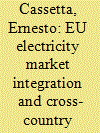| Srl | Item |
| 1 |
ID:
178818


|
|
|
|
|
| Summary/Abstract |
Market efficiency is distorted when retailers are unwilling to pass on changes in wholesale costs or the price of oil (as a major production input cost) to motorists. Existing approaches to measuring pass-through parameters may obscure such behaviour because of the use of fixed-parameter models and/or aggregated price data across different locations and brands over time. We contribute to the literature by examining if there is a mismatch between wholesale and retail petrol prices across different brands supplying unleaded petrol within the same geographical location. To do so, we examine the effects of upstream shocks, arising from changes in oil or wholesale petrol prices, on the retail petrol prices of 672 stations in Sydney, Australia's largest city. We find that the pass-through parameters are significantly lower for stations with fewer competitors in their immediate proximity. When there are fewer than 13 petrol stations within a 5-km radius, or 33 stations within 10 km, irrespective of their brand, they become increasingly less responsive to changes in the wholesale petrol price or the price of crude oil. Our findings enhance market transparency and provide regulators with a rule of thumb that allows them to monitor the unleaded petrol market more effectively.
|
|
|
|
|
|
|
|
|
|
|
|
|
|
|
|
| 2 |
ID:
185691


|
|
|
|
|
| Summary/Abstract |
Despite significant efforts in market integration and regulatory harmonization, large heterogeneities in retail electricity prices across Member States still remain one of the main concerns of the European Union. Here, the cross-country convergence of households and industrial end-user electricity prices in the EU between 2008 and 2021 is investigated. Relying on the notion of club convergence, empirical findings reveal the existence of multiple clubs. The household and non-household market segments exhibit rather different paths in terms of price convergence. Domestic end-user prices show higher dispersion and heterogeneity across national electricity markets than industrial one. Differences across convergence clubs seem to be related with public intervention in the electricity end-user price setting, disparities in the range of household or industrial consumers under regulated end-user prices, and different criteria used among countries in defining energy components. Policy-wise, the club convergence analysis emphasizes the need of stronger cooperation for public intervention and regulation, while considering how end-user price setting can support the decarbonization of the EU electricity systems.
|
|
|
|
|
|
|
|
|
|
|
|
|
|
|
|